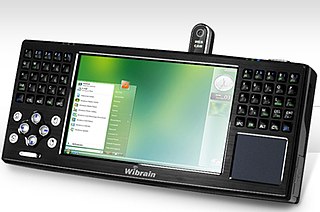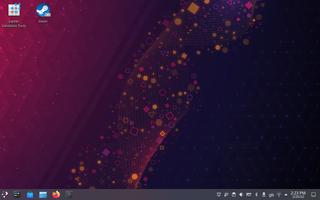
A handheld game console, or simply handheld console, is a small, portable self-contained video game console with a built-in screen, game controls and speakers. Handheld game consoles are smaller than home video game consoles and contain the console, screen, speakers, and controls in one unit, allowing players to carry them and play them at any time or place.
In computing, cross-platform software is computer software that is designed to work in several computing platforms. Some cross-platform software requires a separate build for each platform, but some can be directly run on any platform without special preparation, being written in an interpreted language or compiled to portable bytecode for which the interpreters or run-time packages are common or standard components of all supported platforms.

Wintel is the partnership of Microsoft Windows and Intel producing personal computers (PCs) using Intel x86-compatible processors running Microsoft Windows.

A netbook is a small-sized laptop computer; they were primarily sold from 2007 until around 2013, designed mostly as a means of accessing the Internet and being significantly less expensive.

Hauppauge Computer Works is a US manufacturer and marketer of electronic video hardware for personal computers. Although it is most widely known for its WinTV line of TV tuner cards for PCs, Hauppauge also produces personal video recorders, digital video editors, digital media players, hybrid video recorders and digital television products for both Windows and Mac. The company is named after the hamlet of Hauppauge, New York, in which it is based.

A handheld computer, also called a palmtop computer, is a term that has variously been used to describe a small-sized personal computer (PC) typically built around a clamshell form factor and a laptop-like keyboard, including: Palmtop PCs, personal digital assistants (PDA), ultra-mobile PCs (UMPC) or portable gaming PCs. The brand Handheld PC specifically is a now-defunct class of computers introduced in the 1990s that was marketed by Microsoft, and is detailed below.

The Apple–Intel architecture, or Mactel, is an unofficial name used for Macintosh personal computers developed and manufactured by Apple Inc. that use Intel x86 processors, rather than the PowerPC and Motorola 68000 ("68k") series processors used in their predecessors or the ARM-based Apple silicon SoCs used in their successors. As Apple changed the architecture of its products, they changed the firmware from the Open Firmware used on PowerPC-based Macs to the Intel-designed Extensible Firmware Interface (EFI). With the change in processor architecture to x86, Macs gained the ability to boot into x86-native operating systems, while Intel VT-x brought near-native virtualization with macOS as the host OS.

Subnotebook, also called ultraportable, superportable, handtop, mini notebook or mini laptop, is a type of laptop computer that is smaller and lighter than a typical notebook-sized laptop.

A gaming computer, also known as a gaming PC, is a specialized personal computer designed for playing PC games at high standards. They typically differ from mainstream personal computers by using high-performance graphics cards, a high core-count CPU with higher raw performance and higher-performance RAM. Gaming PCs are also used for other demanding tasks such as video editing. While often in desktop form, gaming PCs may also be laptops or handhelds.

A tablet computer, commonly shortened to tablet, is a mobile device, typically with a mobile operating system and touchscreen display processing circuitry, and a rechargeable battery in a single, thin and flat package. Tablets, being computers, have similar capabilities, but lack some input/output (I/O) abilities that others have. Modern tablets largely resemble modern smartphones, the only differences being that tablets are relatively larger than smartphones, with screens 7 inches (18 cm) or larger, measured diagonally, and may not support access to a cellular network. Unlike laptops, tablets usually run mobile operating systems, alongside smartphones.

An ultra-mobile PC, or ultra-mobile personal computer (UMPC), is a miniature version of a pen computer, a class of laptop whose specifications were launched by Microsoft and Intel in Spring 2006. Sony had already made a first attempt in this direction in 2004 with its Vaio U series, which was only sold in Asia. UMPCs are generally smaller than subnotebooks, have a TFT display measuring (diagonally) about 12.7 to 17.8 centimetres, are operated like tablet PCs using a touchscreen or a stylus, and can also have a physical keyboard. There is no clear boundary between subnotebooks and ultra-mobile PCs, but UMPCs commonly have major features not found in the common clamshell laptop design, such as small keys on either side of the screen, or a slide-out keyboard.

A personal computer, often referred to as a PC, is a computer designed for individual use. It is typically used for tasks such as word processing, internet browsing, email, multimedia playback, and gaming. Personal computers are intended to be operated directly by an end user, rather than by a computer expert or technician. Unlike large, costly minicomputers and mainframes, time-sharing by many people at the same time is not used with personal computers. The term home computer has also been used, primarily in the late 1970s and 1980s. The advent of personal computers and the concurrent Digital Revolution have significantly affected the lives of people.
The history of tablet computers and the associated special operating software is an example of pen computing technology, and thus the development of tablets has deep historical roots. The first patent for a system that recognized handwritten characters by analyzing the handwriting motion was granted in 1914. The first publicly demonstrated system using a tablet and handwriting recognition instead of a keyboard for working with a modern digital computer dates to 1956.

Steam Machine is a discontinued series of small form factor gaming computers by Valve, designed to operate SteamOS to provide a home game console-like experience. Several computer vendors were engaged with Valve to develop their own versions of Steam Machines for retail, offering additional options atop Valve's requirements such as dual-booting options with Microsoft Windows and the ability to upgrade the computer. Consumers could digitally purchase video games on their Steam Machine through Valve's namesake Steam storefront.

SteamOS is a Arch Linux-based Linux distribution developed by Valve. It incorporates Valve's video game storefront Steam and is the official operating system for the Steam Deck, Valve's portable gaming device, as well as Valve's earlier Steam Machines.

The GPD Win 2 is a Windows-based palmtop computer that is the successor to the GPD Win. It is manufactured by Chinese company GamePad Digital and was crowdfunded. Announced in first-quarter 2017, the crowdfunding campaign officially kicked off on January 15, 2018, and it was released in May 2018.

The GPD Win Max is a Windows-based palmtop computer manufactured by Gamepad Digital (GPD). It is the successor to the GPD Win 2, and was crowdfunded, like its predecessor. The GPD Win Max is rated to run AAA video game titles and emulate consoles from the sixth generation and earlier, with some support for consoles up to the eighth generation.

The GPD Win 3 is a Windows-based palmtop computer that is the successor to the GPD Win 2 and GPD Win MAX. It is manufactured by Chinese company Gamepad Digital (GPD) and was crowdfunded.
Comparison of user features of operating systems refers to a comparison of the general user features of major operating systems in a narrative format. It does not encompass a full exhaustive comparison or description of all technical details of all operating systems. It is a comparison of basic roles and the most prominent features. It also includes the most important features of the operating system's origins, historical development, and role.

















